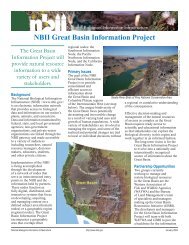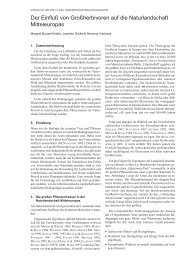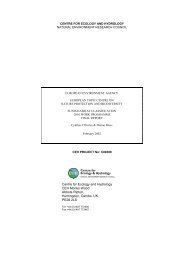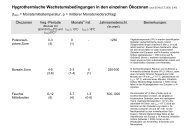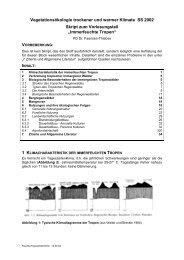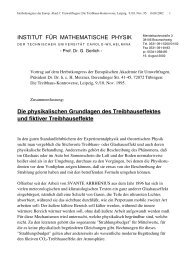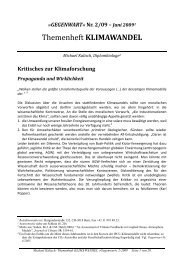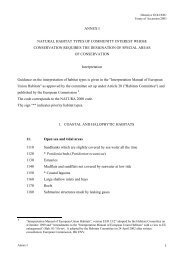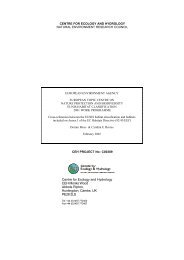Gradient analysis and classification - TU Berlin
Gradient analysis and classification - TU Berlin
Gradient analysis and classification - TU Berlin
Create successful ePaper yourself
Turn your PDF publications into a flip-book with our unique Google optimized e-Paper software.
Lecture 9: Indirect gradient <strong>analysis</strong> IV: weighted<br />
averaging, Correspondence Analysis (CA) <strong>and</strong><br />
Detrended Correspondence Analysis (DCA)<br />
1. Why go further than PCA<br />
2. Weighted averaging<br />
3. Correspondence Analysis (CA)<br />
4. Detrended Correspondence Analysis (DCA)<br />
5. Biplots<br />
6. Review of all ordination techniques
PCA- Why go further<br />
• The linear model just doesn’t fit… species come <strong>and</strong> go across a<br />
gradient. This unimodal response is true with almost any type of<br />
normally-distributed data if you sample it over a large enough gradient.<br />
• Correspondence <strong>analysis</strong> is another eigenvector-based technique that<br />
assume a unimodal, rather than linear, relationship among the<br />
variables.<br />
• As far as what you can do with it, what the graphing looks like, etc. it is<br />
very similar to PCA, the big change is how the axes are derived
Weighted Averaging<br />
• Developed by Curtis <strong>and</strong> McIntosh in their studies of upl<strong>and</strong> forests in<br />
southern Wisconsin<br />
• Important precursor to the application of more advanced multivariate<br />
techniques<br />
• Knowledge of species response along a known environmental gradient<br />
is used to order st<strong>and</strong>s of vegetation along the same gradient<br />
• Species are weighted according to the position of their peak abundance<br />
along the known gradient<br />
• These weightings were then used to provide relative positions of the<br />
st<strong>and</strong>s on the axis.
Weighted averaging: an example<br />
• The weighted average is calculated for each st<strong>and</strong> by multiplying the<br />
abundance of each tree species times the weighting factor for that<br />
species <strong>and</strong> summing the scores for all species <strong>and</strong> dividing by the<br />
sum of abundances of all species<br />
• For example: suppose that we had a set of vegetation samples, <strong>and</strong><br />
we knew a lot about the wetl<strong>and</strong> status of all the species within. We<br />
could then calculate a wetl<strong>and</strong> rating for each sample by taking the<br />
abundance of each species <strong>and</strong> using that to weight it according to its<br />
wetl<strong>and</strong> ranking
Weighted averaging: an example (cont.)<br />
SPECIES WETLAND RANKING COVER WRXC<br />
Juntri 1 2 2<br />
Bigglu 1 4 4<br />
Lupplu 3 3 9<br />
sum: 9 15<br />
In this example the wetl<strong>and</strong> ranking for this sample is 15/9 or 1.67,<br />
reflecting that it is towards the dry each of the gradient
Weighted averaging: an example<br />
• The weighted average is calculated for each st<strong>and</strong> by multiplying the<br />
abundance of each tree species times the weighting factor for that<br />
species <strong>and</strong> summing the scores for all species <strong>and</strong> dividing by the<br />
sum of abundances of all species<br />
• The result is a one-dimensional ordination of the plots along the<br />
environmental axis (in our example, it would be only one point on a line<br />
because we only have one sample or plot).
Weighted averaging: an example (cont.)<br />
Our sample at 1.67<br />
0 1 2 3 4 5 6 7 8 9 10
Weighted averaging: an example (cont.)<br />
• INTERPRETATION<br />
– Species cover values or environmental factor values can be substituded for<br />
plot number along the axis to show distribution of a species’ cover or<br />
environmental factors along the gradient.<br />
– The method shows only one axis <strong>and</strong> is useful for situations where there is<br />
only one primary environmental gradient.<br />
– The major criticism of the method is that the original weights assigned to<br />
each species is based on a subjective assessment of the position of the<br />
species with respect to the gradient, <strong>and</strong> this score could vary from one<br />
worker to another.
Reciprocal averaging (Correspondence Analysis)<br />
• Reciprical averaging works on much of the same principle as weighted<br />
averaging, but rather than forcing an extrenal structure into the results,<br />
it finds inherent structure within a data set.<br />
• Provides the basis for more advanced methods of ordinations<br />
developed after 1970.<br />
• Also at the heart of two-way indicator species <strong>analysis</strong> (TWINSPAN).<br />
• Papers by Hill (1973, 1974) first made CA well known to ecologists.
Basic idea of CA:<br />
• Based on the original matrix, so you get a simultaneous ordination of<br />
species <strong>and</strong> samples (or variables <strong>and</strong> plots…). If you arrange a set of<br />
species <strong>and</strong> samples according to their first axis CA order, they will<br />
look similar to an arranged table, with dominant species in the middle,<br />
<strong>and</strong> rare ones on the ends.<br />
• The method of weighted averages is applied to a data matrix such that<br />
quadrat scores are derived from species scores <strong>and</strong> weightings. These<br />
are carried out successively using an interative procedure. The scores<br />
eventually stablize to get a set of scores for quadrats which give axes<br />
for a quadrat ordination <strong>and</strong> a set of scores for species that provide<br />
axes for a species ordination<br />
• It is this two-way weighted averaging <strong>and</strong> is only slightly more complex<br />
than one-way weighted averaging
Calculation of the first axis<br />
• Calculate the row <strong>and</strong> column totals<br />
• Allocate weights to the species<br />
• Reciprical averaging then commences.<br />
• The averaging pricess is then applied in reverse to give a new set of<br />
scores for the species using the quadrat scores.<br />
• To avoid calculation with very small numbers these new speceis scores<br />
are rescaled from 1 to 100<br />
• The species scores of the final interation are the positions of the<br />
species along the firest axis (0 to 100) of the ordination, <strong>and</strong> the<br />
quadrat scores are the positions of the quadrats along the first axis.<br />
• The contraction in the range of species scores in one interation is the<br />
eigenvalue.
Reciprocal averaging (an example):<br />
SPECIES Sample 1 cover Sample 2 cover Sample 3 cover<br />
Juntri 2 8 1<br />
Bigglu 4 6 3<br />
Lupplu 8 2 1<br />
Average: 4.7 5.3 1.7<br />
Rescale: 83.5 100 1<br />
Rescaling: Example:(speciesvalue-lowest species value)/range of species values x 100
Reciprocal averaging (an example):<br />
SPECIES Sample 1 cover Sample 2 cover Sample 3 cover Weighted average<br />
Juntri 2 8 1 88<br />
Bigglu 4 6 3 72<br />
Lupplu 8 2 1 79<br />
Average: 4.7 5.3 1.7<br />
Rescale: 83.5 100 1<br />
Th next step is to calculate an average value for each species, weighted by the first<br />
axis value.<br />
So: ((83.5*2)+(100*8)+(1*1))/11=88 etc.
Reciprocal averaging (an example):<br />
SPECIES Sample 1 cover Sample 2 cover Sample 3 cover Weighted average<br />
Juntri 2 8 1 88<br />
Bigglu 4 6 3 72<br />
Lupplu 8 2 1 79<br />
Wt. Av. 78.3 80.1 76.6<br />
Rescale 49 100 1<br />
This new vector is used to calculate a new weighted average which is then<br />
rescaled.<br />
So: ((88*2)+(72*4)+(79*8))/14=78.3 etc.
Reciprocal averaging (an example):<br />
Keep going...<br />
SPECIES Sample 1 cover Sample 2 cover Sample 3 cover Weighted average<br />
Juntri 2 8 1 81.7<br />
Bigglu 4 6 3 61.5<br />
Lupplu 8 2 1 53.9<br />
Wt. Av. 78.3 80.1 76.6<br />
Rescale 49 100 1<br />
So: ((49*2)+(100*8)+(1*1))/11=81.7 etc.
Reciprocal averaging (an example):<br />
Keep going...<br />
SPECIES Sample 1 cover Sample 2 cover Sample 3 cover Weighted average<br />
Juntri 2 8 1 81.7<br />
Bigglu 4 6 3 61.5<br />
Lupplu 8 2 1 53.9<br />
Wt. Av. 60 70.6 64.0<br />
Rescale 1 100 57<br />
So: ((81.7*2)+(61.5*4)+(53.9*8))/14=60 etc. Remember to rescale!
Reciprocal averaging (an example):<br />
• Eventually what happens is that IF there is indeed a diagonal<br />
structure to the matrrix (where the species <strong>and</strong> samples<br />
correspond to a diagonal along the middle) then the scores will<br />
stabilize.<br />
• Once they stabilize, you have the first axis!<br />
• The species axis is usually used as a “test” <strong>and</strong> the sample axis<br />
is the weighted average of the species axis.<br />
• If the variables are st<strong>and</strong>ardized scores then the shrinkage of the<br />
axis… although because the cumulative sum of the eigenvalues is<br />
not the same as the sum of the variances the eigenvalues are less<br />
important than in PCA.
Calculation of the second axis<br />
• It is possible to extract a second axis. This will likely be necessary if<br />
there are plots that lie close together in the first axis but which also<br />
have a great deal of differences in species composition. The second<br />
axis is extracted by the same interation process, with one extra step in<br />
which the trial scores for the second axis are made uncorrelated with<br />
the first axis.<br />
• In other words, The linear correlation with the first axis is removed.<br />
This is done by taking the trial scores for the second axis <strong>and</strong><br />
regressing it against the site scores for the first axis. The residuals<br />
from this regression are the new trial axis. This is done once for each<br />
step. (ie. Only for site scores)
Forming the ordination<br />
• The position of the quadrats <strong>and</strong> species in the ordination space is<br />
determined by species scores <strong>and</strong> quadrat scores for the first two axes.
Review of reciprocal averaging (correspondence<br />
<strong>analysis</strong>)<br />
• Axis 1<br />
– Assign r<strong>and</strong>om scores to each species.<br />
– Use these to calculate a weighted average for each sample.<br />
– Rescale these sample scores.<br />
– Use the sample scores to calculate a weighted average for each species.<br />
– Continue until scores converge to a unique solution.<br />
• Axis 2<br />
– Assign a new set of r<strong>and</strong>om scores to each species.<br />
– Calculate a trial axis as above.<br />
– Perform a multiple regression between the trial axis <strong>and</strong> the final axis<br />
obtained (above).<br />
– Take the residual values as the new trial axis.<br />
• Although there’s no definitive cut-off, generally you want an eigenvalue<br />
of at least .25.
Problems with CA<br />
• THE “ARCH EFFECT”<br />
– A mathematical artifact corresponding to no real structure in the data.<br />
– The second axis is a quadratic distortion of the first axis.<br />
– In data sets where there is no strong controlling gradient for the second<br />
axis, the arch effect is likely to occur<br />
• COMPRESSION NEAR THE ENDS OF THE AXES<br />
– Related to the arch effect <strong>and</strong> does not show the actual comings <strong>and</strong> goings<br />
of species along the first axis.
Arch effect <strong>and</strong> compression of the axes: an example
Detrended Correspondence Analysis (DCA)<br />
• Correcting for the arch effect (detrending)<br />
– The first axis is divided into a number of segments <strong>and</strong> within each<br />
segment, the second axis scores are recalculated so that they have an<br />
average of zero.<br />
– In DECORANA, the first axis os divided into many segments <strong>and</strong> the<br />
averaging is achieved through a running averages procedure.<br />
• Correcting for the compression effect<br />
– Also overcome by segmenting the first axis <strong>and</strong> rescaling the species<br />
ordination (not the lot ordination), such that the coming <strong>and</strong> going of species<br />
is about equal along the gradient.
Detrended Correspondence Analysis (DCA) (cont.)<br />
• Scaling of the axes in SD<br />
– The axes in DCA are scaled into units that are the average st<strong>and</strong>ard<br />
deviation of species turnover (SD units).<br />
– A 50% change in species composition occurs in a distance of about 2 SD<br />
unit. Species appear, rise to their modes, <strong>and</strong> disapear over a distance of<br />
about 4 SD units.<br />
– The more SD units that occur along the axis the more change in species<br />
composition is shown. Thus, the axes of DCA are a useful measure of beta<br />
diversity.<br />
– The position of samples along the 1st axis are thus shifted to equalize betadiversity.<br />
Species have, on average, a habitat breadth (as measure by<br />
st<strong>and</strong>ard deviations) of 1.
Detrended Correspondence Analysis (DCA): an<br />
example
Detrended Correspondence Analysis (DCA): an<br />
example
How do you tell if DCA is for you<br />
• A general rule of thumb is that if the axis is less than 2 units long, you<br />
should consider PCA, if it is more than 4 units long then DCA will likely<br />
be appropriate, <strong>and</strong> in between that… you will have to look harder at<br />
the data <strong>and</strong> make some “educated” choices...
Criticism of DCA<br />
• The method used for correcting the arch effect <strong>and</strong> compression have<br />
no emprical or theoritical basis (Wartenberg et. al 1987).<br />
• The assumption that species turnover is constant or even along<br />
gradients is likely not true.<br />
• It removes, with brute force, if needed any arch effect… even there is<br />
really is an arch effect in your data set.<br />
• Because it is done by arbitrarily dividing the axis into pieces, <strong>and</strong> then<br />
shifting those pieces up or down (to get an constant mean), the<br />
relationships within the segment are maintained, but other relationships<br />
can be “ripped” apart.
DCA OVERALL<br />
• Despite these critisms, tehre does not appear to be a good alternative<br />
method at this time, <strong>and</strong> DCA remains one of the most powerful<br />
methods of indirect gradient <strong>analysis</strong> <strong>and</strong> is computationally very<br />
efficient.<br />
• It is the best method to to use when there are no environmental data<br />
• The interpretation of results from DCA is best carried out with some<br />
knowledge of its limitations <strong>and</strong> comparison with other techniques. By<br />
doing this, one can get a better feel for patterns created by actual<br />
structure within the data set.
BIPLOTS<br />
• A useful diagram of the species ordination together with the<br />
environmental factors (Gabriel, 1971).<br />
• Both species <strong>and</strong> environmental factors are plotted on the same graph<br />
but using different scales.<br />
• Arrows are drawn from the joint centred ordination axes to the points<br />
representing species.<br />
– The direction of the arrow indicates the direction in which the abundance of<br />
a variable increases most rapidly.<br />
– The length of the arrow indicates the rate of change in abundance in that<br />
direction.
BIPLOT: an example
Review of all ordination techiques<br />
TECHNIQUE SUMMARY WHEN TO USE<br />
Principal Components PCA is based on the assumption that there Any data set with high linear correlations is<br />
Analysis are linear correlations among the data being appropriate for PCA. This is often a series of<br />
reduced, i.e., that the species or samples are related data, such as climate, soils, or<br />
linearly correlated. The eigenvalues are biogeochemical data. It may be appropriate<br />
correlation coefficients, <strong>and</strong> therefore can be<br />
for community data that have mostly linear<br />
used directly to measure the variance correlations.<br />
explained by the ordination. Higher order<br />
axes are uncorrelated with the first axis,<br />
except that in an oblique solution this is not<br />
enforced.<br />
Correspondence Analysis CA is based on the assumption that the data Most community data sets are appropriate for CA.<br />
have a unimodal response to an underlying<br />
gradient. The eigenvalues vary from 0 to 1<br />
<strong>and</strong> reflect how well the data fit the<br />
ordination model.<br />
Detrended DCA is similar to CA except that it corrects Most community data sets are appropriate for CA.<br />
Correspondence Analysis two major "faults": (1)the presence of a<br />
quadratic relationship between the first two<br />
axes <strong>and</strong> similar relationships with higher<br />
order axes, <strong>and</strong> (2) a compression of scores<br />
toward the ends of the axes.<br />
Canonical Correlation Cancor is based on developing linear Cancor is appropriate when there are two<br />
Analysis combinations of 2 sets variables that distinct sets of data with moderate correlations<br />
maximizes the linear combination between<br />
within them. Lots of high correlations cause<br />
those sets. problems <strong>and</strong> unstable solutions



